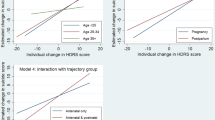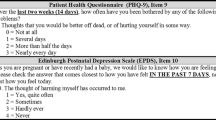Abstract
The aim of this study was to assess suicidality in a non-clinical sample during the perinatal period and to report suicidality rates in women with major or minor depressive episode (MmD), assessed with the SCID, during the perinatal period. Women (1,066) were recruited at the third month of pregnancy and followed until the 12th month postpartum (N = 500). Suicidality was assessed with the MOODS-SR and with item 10 of the EPDS at different time-points during the perinatal period. The period prevalence of suicidality was 6.9% (95% CI: 6.0–7.8) during pregnancy and 4.3% (95% CI: 3.4–5.2) during postpartum, assessed with the MOODS-SR, and was 12.0% (95% CI: 10.8–13.2) during pregnancy and 8.6% (95% CI: 7.4–9.8) during the postpartum period, assessed with the EPDS. The prevalence of suicidality in women who had MmD during pregnancy was 26.4% and 34.1%, assessed with the MOODS-SR and the EPDS, respectively, while it was 18.4% (MOODS-SR) and 30.6% (EPDS) during the postpartum period. Clinicians should assess suicidality in women presenting with MmD during the whole perinatal period. Furthermore, suicidality should be assessed in women with a previous history of psychiatric disorder that reported a lifetime suicidal ideation.



Similar content being viewed by others
References
American Psychiatric Association (APA) (1994) Diagnostic and statistical manual of mental disorders, 4th edn. American Psychiatric Association, Washington, DC
Appleby L (1991) Suicide after pregnancy and the first postnatal year. BMJ 302:137–140
Banti S, Mauri M, Oppo A et al (2011) From the 3rd month of pregnancy to 1 year postpartum. Prevalence, incidence, recurrence and new onset of depression. Results from the perinatal depression-research & screening unit study. Compr Psychiatry 52(4):343–351
Borges G, Nock MK, Haro Abad JM (2010) Twelve-month prevalence of and risk factors for suicide attempts in the World Health Organization World Mental Health Surveys. J Clin Psychiatry. (in press)
Borri C, Mauri M, Oppo A et al (2008) Axis-I psychopathology and functional impairment at the 3rd month of pregnancy. Results from the Perinatal Depression-Research & Screening Unit (PND-ReScU) study. J Clin Psychiatry 69(10):1617–1624
Brockington I (2004) Postpartum psychiatric disorders. Lancet 363:303–310
Burt VK, Stein K (2002) Epidemiology of depression throughout the female life cycle. J Clin Psychiatry 63(7):9–15
Clay EC, Seehusen DA (2004) A review of postpartum depression for the primary care physician. South Med J 97:157–161
Committee on Drugs (2000) Use of psychoactive medication during pregnancy and possible effects on the fetus and newborn. Pediatrics 105:880–887
Condon J (2010) Women's mental health: A “wish-list” for the DSM V. Arch Womens Ment Health 13:5–10
Cox JL, Holden JM, Sagovsky R (1987) Detection of postnatal depression: development of the 10 item Edinburgh Postnatal Depression Scale. Br J Psychiatry 150:782–786
Cox JL, Murray D, Chapman GA (1993) Controlled study of the onset, duration and prevalence of postnatal depression. Br J Psychiatry 163:27–31
Dell'Osso L, Armani A, Rucci P et al (2002) Measuring mood spectrum. Comparison of interview (SCIMOODS) and self-report (MOODS-SR) instruments. Compr Psychiatry 43:69–73
Eberhard-Gran M, Eskild A, Tambs K, Opjordsmoen S, Samuelsen SO (2001) Review of validation studies of the Edinburgh Postnatal Depression Scale. Acta Psychiatr Scand 104:243–249
Evans J, Heron J, Francomb H, Oke S, Golding J (2001) Cohort study of depressed mood during pregnancy and after childbirth. BMJ 323:257–260
Fagiolini A, Dell'Osso L, Pini S et al (1999) Validity and reliability of a new instrument for assessing mood symptomatology: the Structured Clinical Interview for Mood Spectrum (SCI-MOODS). Int J Methods Psychiatr Res 8:71–82
First MB, Spitzer RL, Gibbon M et al (1995) Structured Clinical Interview for DSM-IV Axis I Disorders. New York State Psychiatric Institute, Biometrics Research, New York
Food and Drug Administration (1979) Labeling and prescription drug advertising: content and format for labeling for human prescription drugs. Fed Regist 44:37434–37467
Gaynes BN, Gavin N, Meltzer-Brody S et al (2005) Perinatal depression: prevalence, screening accuracy, and screening outcomes. Evid Rep Technol Assess (Summ) 119:1–8
Gold LH (2002) Postpartum disorders in primary care: diagnosis and treatment. Prim Care 29:27–41
Halbreich U, Karkun S (2006) Cross-cultural and social diversity of prevalence of postpartum depression and depressive symptoms. J Affect Disord 91:97–111
Hawton K, van Heeringen K (2009) Suicide. Lancet 373(9672):1372–1381
Hawton K, Sutton L, Haw C et al (2005) Suicide and attempted suicide in bipolar disorder: a systematic review of risk factors. J Clin Psychiatry 66:693–704
Heron J, Connor TG, Evans J, Golding J, Glover V (2004) The Alspac study team. The course of anxiety and depression through pregnancy and the postpartum in a community sample. J Affect Disord 80(1):65–73
Horowitz JA, Murphy CA, Gregory KE, Wojcik J (2010) A community-based screening initiative to identify mothers at risk for postpartum depression. J Obstet Gynecol Neonatal Nurs. (in press)
Jenkins R (2002) Addressing suicide as a public-health problem. Lancet 359(9309):813–814
Kitamura T, Yoshida K, Okano T, Kinoshita K, Hayashi M, Toyoda N et al (2006) Multicentre prospective study of perinatal depression in Japan: incidence and correlates of antenatal and postnatal depression. Arch Womens Ment Health 9:121–130
Lewis G (2004) Confidential enquiry into maternal and child health. Why mothers die 2000–2002. Sixth report of the Confidential Enquiries into Maternal Deaths in the United Kingdom. Ch. 11A: Deaths from suicide and other psychiatric causes. RCOG Press, London
Lindahl V, Pearson JL, Colpe L (2005) Prevalence of suicidality during pregnancy and the postpartum. Arch Womens Ment Health 8(2):77–87
Luoma I, Tamminen T, Kaukonen P et al (2001) Longitudinal study of maternal depressive symptoms and child well-being. J Am Acad Child Adolesc Psychiatry 40:1367–1374
Manber R, Blasey C, Allen JJ (2008) Depression symptoms during pregnancy. Arch Womens Ment Health 11(1):43–48
Mann JJ (2003) Neurobiology of suicidal behavior. Nat Rev Neurosci 4:819–828
Moller HJ (2003) Suicide, suicidality and suicide prevention in affective disorders. Acta Psychiatr Scand 418:73–80
Mota NP, Burnett M, Sareen J (2010) Associations between abortion, mental disorders, and suicidal behaviour in a nationally representative sample. Can J Psychiatry 55(4):239–247
Oates M (2003) Perinatal psychiatric disorders: a leading cause of maternal morbidity and mortality. Br Med Bull 67:219–229
O'Hara M, Swain A (1996) Rates and risk of postpartum depression: a meta-analysis. Int Rev Psychiatry 8:37–54
Oquendo MA, Currier D, Mann JJ (2006) Prospective studies of suicidal behavior in major depressive and bipolar disorders: what is the evidence for predictive risk factors? Acta Psychiatr Scand 114(3):151–158
Pinheiro RT, da Silva RA, Magalhães PV, Horta BL, Pinheiro KA (2008) Two studies on suicidality in the postpartum. Acta Psychiatr Scand 118(2):160–163
Reck C, Struben K, Backenstrass M et al (2008) Prevalence, onset and comorbidity of postpartum anxiety and depressive disorders. Acta Psychiatr Scand 118:459–468
Sit D, Seltman H, Wisner KL (2011) Seasonal effects on depression risk and suicidal symptoms in postpartum women. Depress Anxiety 28(5):400–405
Skouteris H, Wertheim EH, Rallis S, Milgrom J, Paxton SJ (2009) Depression and anxiety through pregnancy and the early postpartum: an examination of prospective relationships. J Affect Disord 113:303–308
Sokero P, Melartin T, Rytsala H et al (2003) Suicidal ideation and attempts among psychiatric patients with major depressive disorder. J Clin Psychiatry 64:1094–1100
Sutter-Dallay AL, Giaconne-Marcesche V, Glatigny-Dallay E, Verdoux H (2004) Women with anxiety disorders during pregnancy are at increased risk of intense postnatal depressive symptoms: a prospective survey of the MATQUID cohort. Eur Psychiatr 19:459–463
Acknowledgments
The PND-ReScU staff includes Cristina Rambelli, MD, Daniele Ramacciotti, MD, Maria Sole Montagnani, MD, Sonia Cortopassi, MD, Valeria Camilleri, MD, Amparo Bettini, D.Psych., Serena Ricciardulli, D.Psych., Serena Luisi, D.Psych., and Caterina Cirri, D.Psych. This research was funded with a grant from the Italian Ministry of Health and with liberal grants from the “Istituto per la ricerca e la prevenzione della Depressione E dell'Ansia” (IDEA), the Stella Major Foundations (no-profit advocacy associations), and Pfizer Italia. The authors would like to thank all the women who participated, without whom this study would not have been possible.
Author information
Authors and Affiliations
Consortia
Corresponding author
Rights and permissions
About this article
Cite this article
Mauri, M., Oppo, A., Borri, C. et al. SUICIDALITY in the perinatal period: comparison of two self-report instruments. Results from PND-ReScU. Arch Womens Ment Health 15, 39–47 (2012). https://doi.org/10.1007/s00737-011-0246-y
Received:
Accepted:
Published:
Issue Date:
DOI: https://doi.org/10.1007/s00737-011-0246-y




